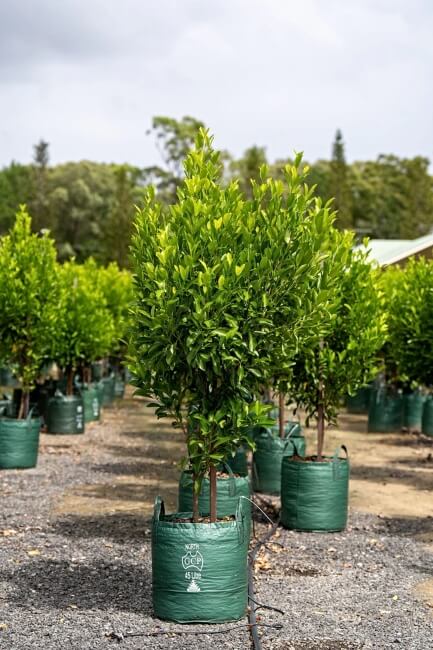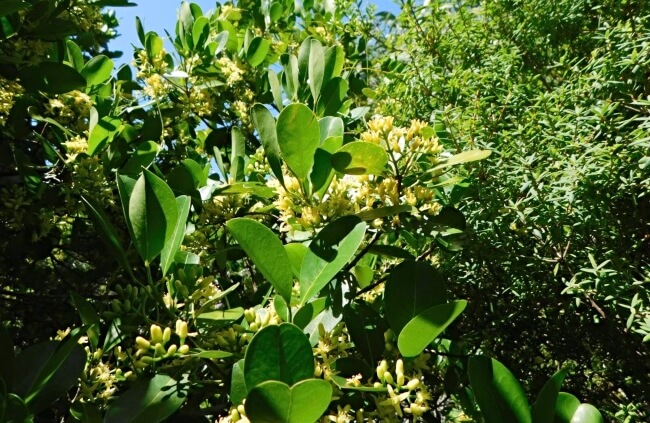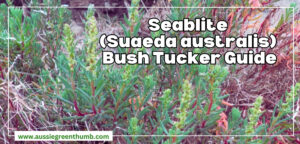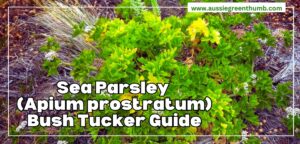Fraser Island Apples are probably the most underrated and underrecognized bush tucker foods. Packed with flavour, and a tart, fleshy bite they are definitely worth getting to know.
So, as well as a concise guide to growing your own Fraser Island apple tree, we’ve got a simple identification guide to keep you safe out foraging.
More...
Family: | Rutaceae |
|---|---|
Genus: | Acronychia |
Species: | A. imperforata |
Common names: | Fraser Island apple, logan apple, green tree |
Origin: | Australia |
Location: | Outdoor |
Type: | Edible, bush tucker, fruit tree |
Growth: | 9-10 m tall |
Sun requirements: | Full sun to part shade |
Foliage colour: | Green |
Flower colour: | Pale green |
Flowering: | Summer and autumn |
Edible parts: | Fleshy peach-coloured fruit |
Maintenance level: | Medium |
Poisonous for pets: | No toxicity reported |
About the Fraser Island Apple Tree

Source: Brisbane Plant Nursery
The Fraser Island apple is a beautiful and productive tree, well worth growing at home, either as a tree, shrub or hedge. It grows to about 10 m tall at its tallest but can be kept short, or grown in pots for smaller gardens.
After a slight winter chill (not frost!), they can develop massive amounts of small, fleshy fruits with a smooth but tart flavour, ideal for baking and a perfect alternative to candied peel.
As the common name suggests, Fraser Island apple trees are native to the forests of Fraser Island, so they like full sun and can cope with some shade from taller trees. They are drought-tolerant and like cool winters without frosts.
Identifying Fraser Island Apple Trees
Fraser Island apple trees are difficult to distinguish from other citrus trees until they are in fruit, but their flowers give them away, with pale green buds opening in clusters.
Once the fruit develops, they have a very fine rind and typically form round or slightly egg-shaped berries. The berries are a creamy-orange colour, and when cut open have four hollow seed segments surrounded by an even peach-coloured flesh.
The leaves of Acronychia imperforata are smooth ovate leaves with a clear point at either end, with a glossy deep-green surface and a matt pale-green underside with a risen pale yellow midrib.
Fruits are ripe and ready to eat when they are soft to the touch and twist away from the tree with a gentle rocking action. Do not eat unripe fruit as it can give you indigestion.
Common Uses for Fraser Island Apples
Fraser Island apples are a great feature tree for your garden and make a wonderful hedge. They grow slowly like all members of the citrus family (Rutaceae), so annually pruning new growth back into the hedge dimensions is enough to encourage fruit in a small space.
The most common use for Fraser Island apples is as a basic bush tucker. Whether you’re foraging, or growing them at home, they have a distinctive tart but smooth creamy flavour, which is an acquired taste.
Most gardeners will turn them into jams, syrups or chutneys to soften the tartness and celebrate the creamy, fruity notes beneath the initial bitterness.
However, one brilliant way to make the most of their texture, and flavour is to use a simple candied fruit recipe so you’ve got decorative slices of candied Fraser Island apples for topping cakes. Once prepared these sweets will last for years in an air-tight container.


Get Your Free Guide:
Master Growing Australian Natives eBook
A Must Have Complete Guide for Every Australian Garden
Get Your Free Guide:
Master Growing Australian Natives eBook
A Must Have Complete Guide for Every Australian Garden
How to Grow Fraser Island Apple Trees

Source: Coolum Native Nursery
Fraser Island apples are pretty easy to grow. Pruning isn’t complicated, and they can tolerate a range of soil conditions and lighting. Winter care, as we’ll talk about later, is probably the most important factor in growing decent edible fruit.
Propagating Fraser Island Apple Trees
Fraser Island apples can be grown from seed, but are most commonly grown from cuttings and grafted onto a dwarfing rootstock, like any other citrus tree for home-growing. However, young trees are relatively easy to come by in specialist native plant nurseries.
If you want to try taking cuttings the easy way, make sure you’ve got liquid rooting gel, and some old compost, perlite, grit and/or sand. A mix of any of that, with a generous dip of the cut end in rooting gel will pretty much guarantee a rooted cutting in 1-2 months’ time.
Use early-summer growth of your Fraser Island apple tree, taking a 15-20 cm cutting and removing any flowers or flower buds before placing the cut end in rooting gel, and then into moist compost.
Cover the pot with a clear plastic bag and keep it somewhere warm and bright, but out of direct sunlight. Keep the soil moist, and within around two months it should have signs of new growth. By next spring, if your cutting has worked it will have plenty of roots and can be planted into compost to grow on.
Best Conditions for Growing Fraser Island Apple Trees
Plant young Fraser Island apples in a free-draining or well-drained spot in the garden. They can tolerate a range of soil conditions, from moist clay to sand, and are very drought tolerant through summers.
Like any plants in the Rutaceae family, they don’t like wet or freezing winters, so should be protected by fleece or planted in pots and moved indoors to protect from extreme winters.
Choose a bright, sunny spot, with at least 8 hours of direct light per day. Fraser Island apples can grow with 6 hours of light or some shade, but produce a better crop in more direct sunlight.
Growing Fraser Island Apples in Pots
Fraser Island apples grow beautifully in pots. Use a standard citrus potting mix or a mix of sandy loam and garden compost. They are a native Australian plant, with a distinctly Mediterranean vibe, so look elegant in a raised terracotta pot with a layer of grit on top of the soil.
When planting these trees in pots, leave at least an inch of space between the soil surface and the rim of the pot. They require regular watering through summer, and an annual mulch to boost nutrition, so the more space you can leave for mulching and watering the better.
Caring for Fraser Island Apple Trees
While Fraser Island apples like free-draining soil, and hot conditions, they also need plenty of moisture in summer. While it might seem counterintuitive, the most important part of their regular care is to add a thick layer of organic mulch in late spring to help lock moisture in at the roots.
As with any tree mulching, keep a ring of 10-15 cm clear around the base of the tree, to avoid damp contact with the trunk.
Other than that, just protect your trees from winter frosts, either with horticultural fleece or by moving potted plants indoors, or into greenhouses over winter.
Harvest & Store Fraser Island Apples

Source: Burringbar Rainforest Nursery
Fraser Island apples really don’t store very well. They last on the counter or in the fridge for about a week. Because of their large hollow seed cavities, they tend to sink in and shrivel quickly, so either freeze them for long-term use in sauces, cooking and jams or chutneys, or preserve them as candied fruits, or jams while they’re fresh.
Like lemons and other citrus fruits, these tart little treats can also be frozen whole and then grated as a garnish or seasoning in curries and rice dishes.
Problems When Growing Fraser Island Apple Trees
Well-fed, healthy Fraser Island apples are resilient plants. Other than common root rot caused by poorly drained or existing fungal problems in the soil, there are very few issues faced by these resilient trees.
They are well adapted to cope with common pests, and less attractive to citrus pests than other trees in the Rutaceae family.
Fraser Island Apple Trees FAQs
Are Fraser Island apple trees true apples?
Fraser Island apple trees aren’t apples and share very little in common with them. They are actually part of the wider citrus family, Rutaceae, and are closer in size and shape to a crabapple.
How do you keep the Fraser Island apple as a hedge?
It’s easy to keep the Fraser Island apple Tree as a hedge. It naturally grows to about 10 cm tall, so planting at 1-2 m intervals and restricting that growth to 4 m makes for a neat, bushy shrub, that can be pruned branch by branch, or trimmed with a hedge trimmer. Both methods offer neat results.
Wrapping Up Our Fraser Island Apple Trees Guide
I accept that these native bush tucker trees are an acquired taste. They are best described as sharply tart, with creamy flesh, so it’s a flavour that lends itself best to seasoning, rather than enjoyed by itself.
Having said that, they are packed with nutrients, and utterly unique, in form and flavour, so well worth growing as a bush tucker food at home. They offer a more vigorous native option for the look of citrus trees in the garden, making them useful ornamental garden trees.
Published on August 30, 2025 by Nathan Schwartz
Last Updated on January 26, 2025




